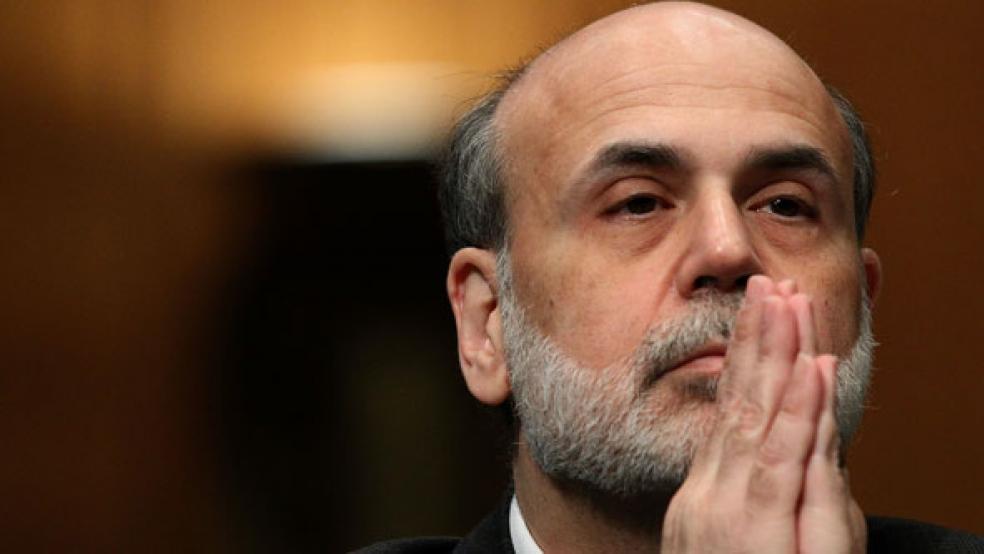The Federal Reserve said on Wednesday the economy continues to recover but is still in need of support, offering no indication that it is planning to reduce its bond-buying stimulus at its next meeting in September.

The central bank said after a two-day meeting that it would keep buying $85 billion in mortgage and Treasury securities per month in its effort to strengthen an economy that it said was still challenged by federal budget-tightening. It also pointed to a recent run up in mortgage rates.
RELATED: FOUR WAYS THE FED IS CREATING HARMFUL UNCERTAINTY
In a post-meeting statement, policymakers described economic activity as having expanded at a "modest" pace in the first half of the year. They had called the recovery "moderate" after their last meeting in June.
In another departure, the Fed's policy-setting committee signaled some concern about the low level of inflation.
"The committee recognizes that inflation persistently below its 2 percent objective could pose risks to economic performance, but it anticipates that inflation will move back toward its objective over the medium term," the Fed said.
Financial markets saw the Fed's statement as having a slightly dovish tilt. U.S. stocks added slightly to gains, while prices for U.S. government bonds pared losses and the dollar briefly slipped against the euro and the yen.
"The Fed bought itself some time in terms of when they need to begin to taper" bond purchases, said Brian Jacobsen, a chief portfolio strategist at Wells Fargo Funds Management in Menomonee Falls, Wisconsin. "They were painting themselves into a corner with previous statements."
EYE ON PRICES
The Fed's reference to the low level of inflation was enough to prevent St. Louis Federal Reserve Bank President James Bullard, who last month expressed concern about falling price pressures, from dissenting for a second straight time.
Esther George of the Kansas City Fed, however, once again voted against the bond-buying decision due to concerns about potential harm to financial stability from the central bank's prolonged easy monetary policy, as she has at every meeting this year.
The Fed cut interest rates to almost zero in late 2008 and has since more than tripled the size of its balance sheet to around $3.6 trillion via three massive rounds of bond buying aimed at holding down longer-term borrowing costs.
At a news conference on June 19, Fed Chairman Ben Bernanke said the central bank likely would start to curtail its current bond-buying round later this year, with an eye toward bringing it to a close by the middle of 2014. Financial market participants have widely anticipated a reduction in purchases at the Fed's next meeting on September 17-18.
A government report on Wednesday showed the U.S. economy expanded at a faster-than-expected 1.7 percent annual rate in the second quarter, but the growth figure for the first quarter was revised down to 1.1 percent from 1.8 percent.
Further, the report showed consumer prices held steady in the quarter, with so-called core prices advancing at a 0.8 percent pace, well below the Fed's 2 percent target.
Officials, however, expect the economy will soon pull out of its soft patch.
Even as it tip toes toward a curtailing of its bond purchases, the Fed has gone out of its way to stress that any pull-back would not mean it was anywhere near jacking up interest rates.
It reiterated on Wednesday that it will hold rates near zero for as long as the unemployment rate remains above 6.5 percent, provided that the outlook for inflation between one and two years ahead is not projected to rise above 2.5 percent.
The jobless rate stood at 7.6 percent in June, and economists expect a report on Friday to show it ticked down to 7.5 percent in July.
Despite the Fed's best efforts to use its forward guidance on rates to hold down longer-term borrowing costs, markets have responded to talk of a likely reduction in the central bank's asset purchases by selling bonds.
The yield on the benchmark 10-year U.S. Treasury note stands about a full percentage point above where it was in early May. Mortgage rates have risen a similar amount, posing a potential risk to the housing recovery.
"Household spending and business fixed investment advanced, and the housing sector has been strengthening, but mortgage rates have risen somewhat and fiscal policy is restraining economic growth," the Fed said.
This article is by Alister Bull and Pedro da Costa of Reuters.




